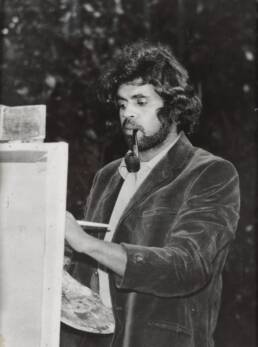These stories may contain descriptions of childhood trauma and abuse. Aboriginal and Torres Strait Islander people should be aware that this website may contain images, voices or names of people who may have passed away. If you need help, you can find contact details for some relevant services on our support page.
Aboriginal Australian artist, Ronald Elliot Bull (1942-1979), was in residential and foster care as a child.
Ronald Bull, a member of the Stolen Generations, was born at Lake Tyers Mission Station on Gunaikurnai country in the Gippsland region of Victoria. Protests by the Aboriginal community for ten years between 1956 and 1965 resulted in 4000 acres of land being returned to the community by the Victorian Government in 1971 and the area is now known as Bung Yarnda.
Ronald’s parents were Alfred Marshall Bull, a labourer, and Agnes, née Moore, who made feather flowers. The couple had twenty-one children, seventeen of whom survived into adulthood.
Ronald was first removed from his family when he was only four months old. He was returned to his parents “for primary school” (Holsworth) but at the age of twelve was sent to Tally Ho Boys Training Farm in Burwood, a suburb of Melbourne. At the age of fifteen, Ronald went into foster care in Lilydale, an outer suburb of Melbourne.
Ronald studied painting informally with Melbourne-based Archibald Prize winning artist, Ernest Buckmaster, and corresponded and visited with famed German-born South Australian artist, Hans Heysen.
Ronald Bull served time in Pentridge Prison on several occasions for minor offences. In 1960, he painted a mural in a walkway of F-Division, using house paint to depict a scene of Aboriginal life prior to colonisation. After Pentridge was closed in 1997, the mural was preserved and is now included on the Victorian Aboriginal Heritage Register.
Ronald Bull held his first exhibition in 1965. During 1966-1967, he exhibited with Keith Namatjira (1938-1977), a son of renowned Aboriginal Australian artist and Western Arrernte man, Albert Namatjira (1902-1959).
By the 1970s, Ronald Bull was exhibiting consistently, including with well-known non-Indigenous artists Pro Hart and Ernest Vogel.
Ronald Bull died of hypotensive cardiovascular disease on 8 September 1979.
Bull’s talent and tenacity ensured that, against all odds, he achieved success as an artist. Once relegated to obscurity, he is now considered a significant figure in the regional history of Aboriginal Australia, a parallel in the south-east for Namatjira and a precursor to a later Koori art movement in Melbourne (Kleinert).
References:
“Ronald Elliott Bull. Australia (Aboriginal), 1942-79. Australian and New Zeald Arts Sales Digest. https://www.aasd.com.au/index.cfm/list-all-works/?concat=BullRonal
“Bung Yarnda (Lake Tyers Mission).” Deadly Story. https://www.deadlystory.com/page/aboriginal-country-map/Community_Places/Bung_Yarnda_Lake_Tyers_Mission
“’Frosty Morning At Pembrooke’ Ronald Elliot Bull (Australian Aboriginal 1942-1979).” The McCorry Collection. https://themccorrycollection.com/m/shop/product/frosty-morning-at-pembrooke-by-ronald-elliot-bull-australian-aboriginal-1942-1979/
Holsworth, Mark. “The life and art of Ronald Bull.” Black Mark. Melbourne Art & Culture Critic. https://melbourneartcritic.wordpress.com/2018/03/05/the-life-and-art-of-ronald-bull/
Kleinert, Sylvia. “Bull, Elliott Ronald (1942-1979).” Australian Dictionary of Biography, 2006. https://adb.anu.edu.au/biography/bull-elliott-ronald-12826
“Lake Tyers Mission Station (1861-1971).” Find and Connect, 2021. Available here.
“Tally Ho Boys’ Training Farm (1903-1986).” Find and Connect, 2021. https://www.findandconnect.gov.au/guide/vic/E000119
Image available here.
